When the 2018 Land Rover Range Rover Velar gets into the hands of customers, 99 percent of them likely won’t be tackling trails through the desert badlands, but that doesn’t mean they can’t.
Land Rover brought us to the outskirts of Palm Springs to show us just what they can do off-road and on winding canyon roads in the area. While owners might not go on any trails as challenging as those we faced crawling over boulders and flying down sandy sideroads, people are still drawn to the brand because of its mystique and its ability to reach the most remote corners of the globe.
Brand Credentials
Even though it was developed alongside the Jaguar F-Pace, which is focused almost exclusively on paved roads, the Range Rover Velar isn’t just a different way to skin a cat, it’s an entirely different beast.
With a maximum 9.9 inches (251 millimeters) of ground clearance from its air suspension or 8.4 in. (213 mm) with the standard coil-spring suspension and increased suspension travel over the F-Pace, the Velar can tackle some pretty rough terrain. The all-wheel drive is fully automated but selectable, the aggressive settings jacking up the ride height and adjusting throttle, transmission and differential behavior to rein in torque and give you better control when balancing and crawling over obstacles. Other off-road specs include a 24.5-degree approach angle, 20.3-degree breakover angle, a 27.0-degree departure angle, and a maximum wading depth of 25.6 in. (650 mm). On coil-spring models, wading is limited to 23.6 in. (600 mm); that’s still almost two feet, people. Two feet. There are also some cool monitoring displays that show horizontal and longitudinal angle or wheel angle and suspension articulation.
Get the Flash Player to see this player.
Despite the off-road worthiness, the Velar’s true hunting grounds will be downtown cores and suburban malls, and here also Land Rover engineers worked hard to provide the Velar with an experience distinct from the more raucous F-Pace.
More sound deadening, that added suspension travel and chassis tuning make for a more isolated and serene cabin, which will be very pleasant on commutes into the city. Automated driving systems will help ease the burden and carry you with the flow of traffic and wrap you in a protective bubble of active safety systems and a supremely rigid structure made of mostly aluminum, with magnesium and steel used in key places to improve weight balance between the front and rear. And despite the added sound suppression and suspension upgrades, the Velar only adds about 100 pounds over equivalent F-Pace models, so it’s not a significant amount for a vehicle weighing over 4,000 pounds (over 1,900 kg).
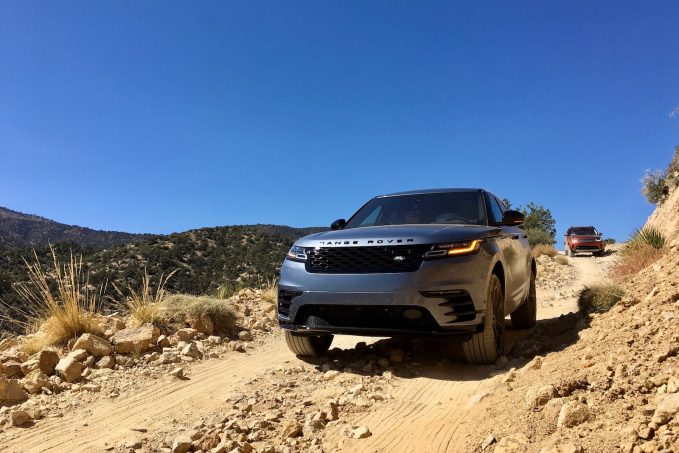
Power Range
The Velar essentially has two entry-level powertrains, and then a top trim V6 that should more than satisfy your power cravings.
We started the day off in that V6 (which is indicated by a P380 badge on the tail), which is a supercharged 3.0L familiar from just about everything in the Jaguar Land Rover lineup, and the Velar delivers its 380 horsepower with a muted enthusiasm compared to the F-Pace, even in its most aggressive Dynamic mode. Torque is a generous but not overwhelming 332 pound-feet from 3,500 to 5,000 rpm, but with a lightweight architecture keeping mass in check at 4,471 pounds, the Velar can reach 60 mph in as little as 5.3 seconds and it feels plenty fast for a midsize luxury cocoon.
All powertrains share an impeccably tuned eight-speed automatic transmission sourced from transmission specialist ZF. Shifts are seamless in comfort mode, clever enough in dynamic mode, and can quickly be locked into first gear in manual mode using the paddle shifters when off-roading.
The efficiency option is a 2.0-liter four-cylinder turbocharged diesel powerplant (D180) rated at 180 hp and 317 lb-ft of torque. Although peak torque arrives at an early 1,500 rpm, the diesel runs out of steam quickly and struggled to make quick work of passing maneuvers. Its acceleration estimate confirms that it is not fast, taking 8.4 seconds to reach 60 mph (8.9 to 100 km/h). Official fuel consumption ratings are not yet published, so it will be some time before we find out just how efficient this diesel and the other powertrains are.
ALSO SEE: 2018 Range Rover Sport Adds Plug-in Hybrid Variant
The base powertrain in the U.S. is a 2.0L turbocharged four-cylinder gasoline model (P250) with 247 hp and a broad range of 269 lb-ft of torque from 1,200 to 4,500 rpm. It’s no rocketship, but it reaches 60 in a respectable 6.4 seconds (6.7 to 100 km/h) and doesn’t suffer the same sluggishness as the diesel at passing speeds. If I had to choose, this would be my compromise for efficiency and power, as it’s also the value option, available in the base $50,895 model ($995 freight included in all prices) and all the way up to the R-Dynamic HSE trim at $68,595. Diesel models start at $57,195 and the supercharged V6 starts at $65,195. However, the V6 we tested ran right up to about $90K, and both the four-bangers were about $75K so the options don’t come cheap.
Canadians are not offered the 2.0L gasoline engine, so pricing starts at CAD$64,095 ($2,095 freight included) for the four-cylinder diesel and the V6 at CAD$71,995.
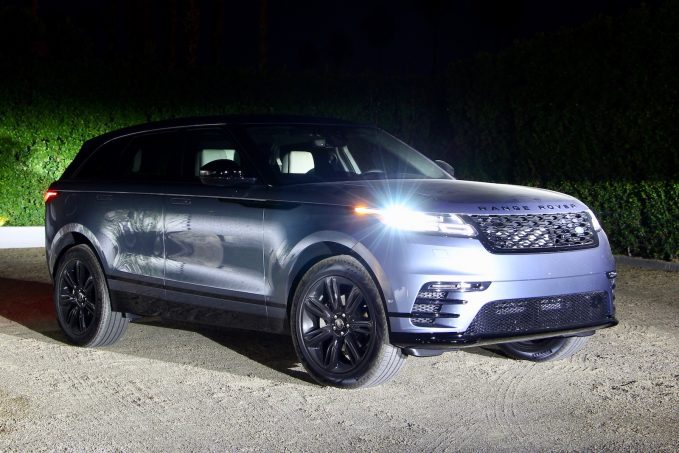
A Fair Compromise
Truly, the power is fine for most scenarios, but despite its sleek shape, the Velar is still more smooth-riding SUV than canyon carver, and that is just what Land Rover was aiming for. The long suspension travel makes easy work of any rough roads, especially in comfort or efficiency modes, and any wind or tire noise is negligible in the face of the Meridian 23-speaker audio system as equipped (audio starts with an eight-speaker system, then jumps to 11 and 17 before getting to this sound unit). When looking to hustle a bit, Dynamic mode firms up steering and damping, sharpens throttle and transmission responses, but it’s still a lot of mass and the standard ride height is over eight inches with either suspension, which is still a long way off the ground, so body roll and some understeer arrives early in corners.
ALSO SEE: Range Rover Velar SVR Spied Playing With a Friend
Whether because of weight or the fixed suspension, again the 2.0L gasoline powerplant felt like the ideal middle ground its 4,217 lb (1,912 kg), easier to control and the suspension showing excellent compromise between a comfortable ride and holding firmly in corners.
And of course, the AWD system isn’t just for off-roading, as it benefits dry road handling with front-rear torque distribution, defaulting to rear drive but able to shuffle power forward within 100 milliseconds. An optional electronic locking rear diff takes it even further for traction on loose surfaces and manages torque between the rear wheels during acceleration, so it should handle the snow and slush of northeast winters with no stress.
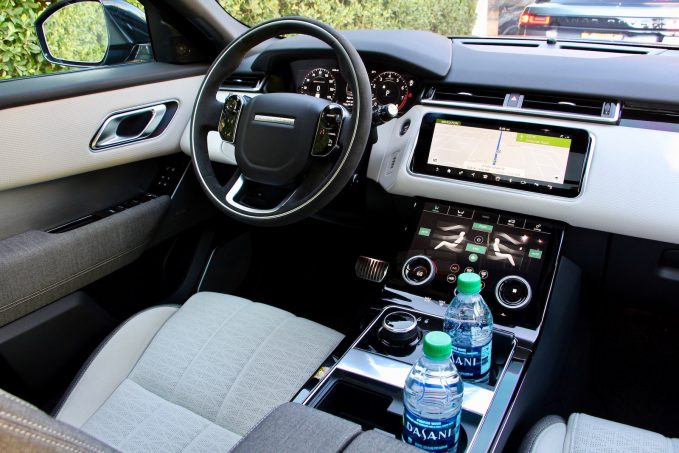
Interior Appeal
However, where the Velar has really set itself apart is the introduction of a new interior. While not quite as minimalist as Tesla’s screen-only approach, Range Rover’s clean but luxurious mix is my personal favorite design in the industry right now. The design embraces the horizontal sweep of the dash in simple, layered sections, with vents tucked into one layer and a pair of wide touchscreens with supporting knobs whose function changes depending on the menu.
The screen is wider and pops up to make it easier to reach, the system responds more quickly, making it less frustrating than previous Land Rover offerings. The top primary screen is reserved for common systems like navigation, phone and audio, while the lower screen handles more of the set-and-forget functions like climate and vehicle settings like terrain response and safety systems.
The gauge cluster can be outfitted as a 12.3-inch TFT digital cluster with four viewing modes and a head-up display is also available. Analog gauges are standard with a smaller digital display nestled between them.
ALSO SEE: 2018 Audi Q5 Review
The new design also brings new materials into play, but the best new combination has to be the synthetic suede produced from recycled plastic and a custom fabric from an unpronounceable Danish cloth manufacturer – Kvadrat – you know it must be good when you can’t even say their name! For traditionalists, the seats and dash can be covered in delectable Windsor leather.
Practically speaking, the Velar is about the same width as the Range Rover Sport, three inches shorter in length and five inches lower, but it’s over a foot longer than the Range Rover Evoque, so it’s decently sized. You might think that swoopy shape sacrifices cargo space and headroom, and the Range Rover Sport is certainly larger, but the Velar manages just fine, with 34.4 cubic feet in the trunk – almost twice as much trunk space as the best-selling Lexus RX 350 (listed at 18.4), and similar to the Mercedes-Benz GLE SUV (38.2).
There is also plenty of head and legroom in both rows, and the top-spec seats offer all the requisite adjustments and a soothing massage function. The options list goes on forever, so I won’t bore you with that, and overall, more than the features themselves it’s how they all come together to work intuitively that makes the Velar interior a relaxing environment.
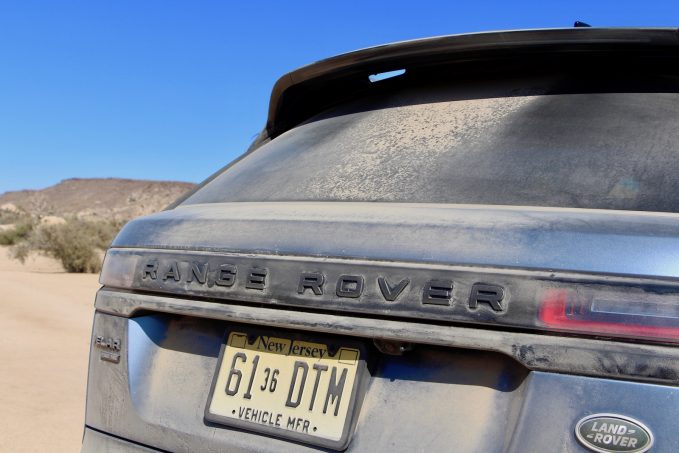
The Verdict: 2018 Range Rover Velar Review
After tackling a trail that I would never have expected the Velar to clear, it also proved it is every bit the capable road car, whether cruising quietly and smoothly down the highway or having a bit of fun on winding roads, all while wrapped in a gorgeous, refined cabin.


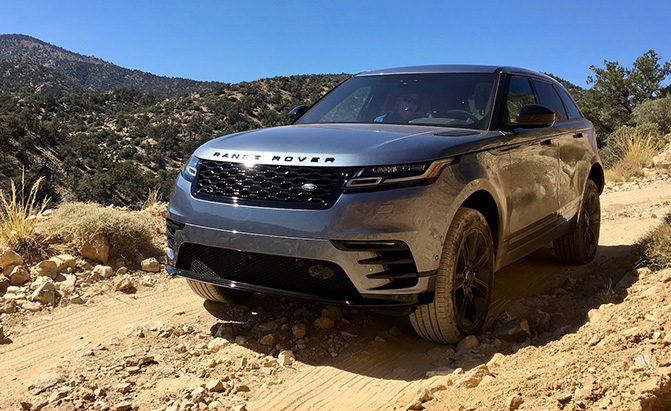
Leave a Reply